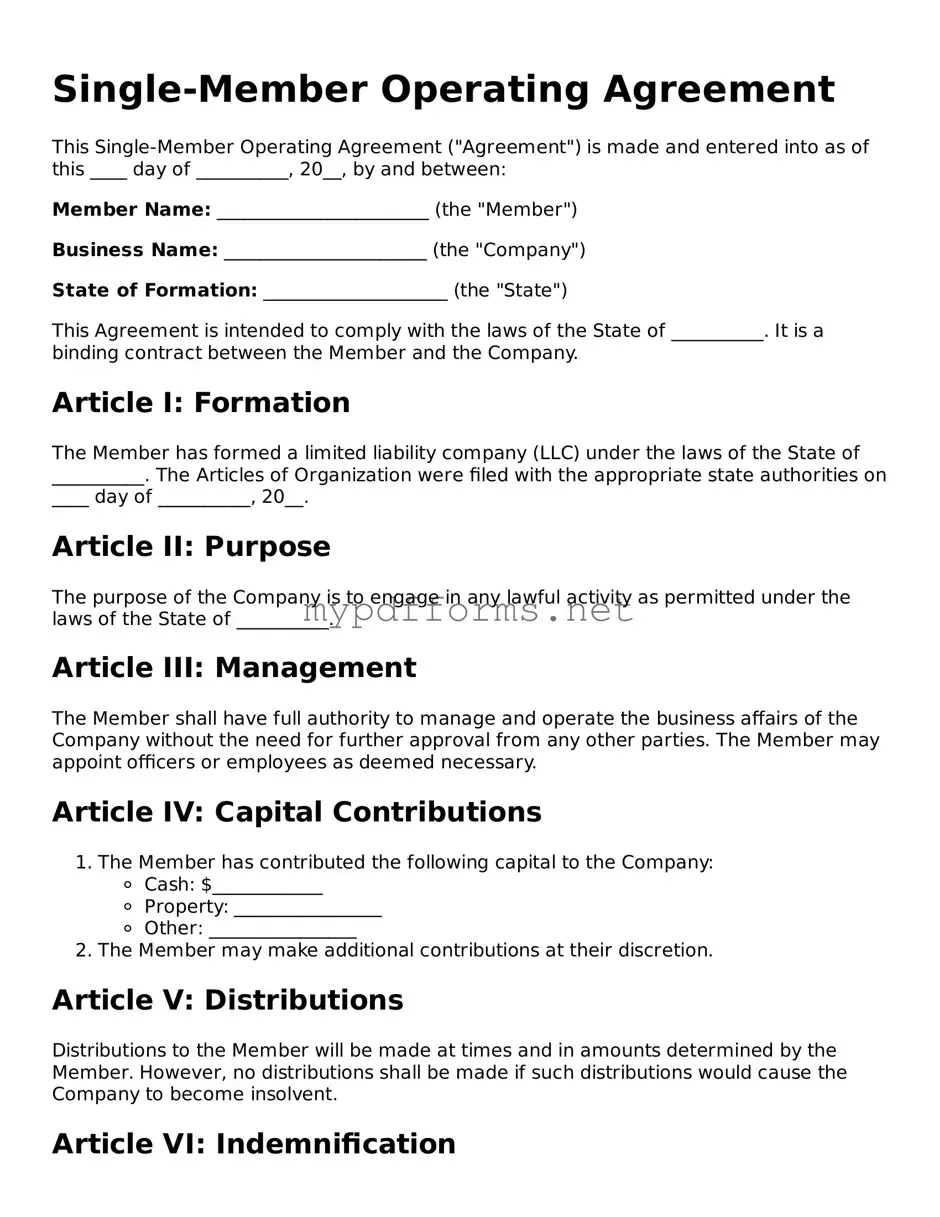The Single-Member Operating Agreement is often compared to a Partnership Agreement. While a Partnership Agreement outlines the relationships and responsibilities among multiple partners, the Single-Member Operating Agreement focuses solely on the rights and obligations of a single owner. Both documents serve to clarify the management structure and operational procedures of a business, but the Single-Member Operating Agreement is tailored for individual ownership, ensuring that the owner has complete control and clarity regarding the business's operations.
Another similar document is the Bylaws of a corporation. Bylaws establish the internal rules governing the management of a corporation, including how decisions are made and how meetings are conducted. Like the Single-Member Operating Agreement, bylaws are essential for outlining governance. However, while bylaws are typically used for corporations with multiple shareholders, the Single-Member Operating Agreement is specifically designed for single-member entities, providing a streamlined approach to governance for individual owners.
The Articles of Organization can also be likened to the Single-Member Operating Agreement. This document is filed with the state to formally create a Limited Liability Company (LLC). While the Articles of Organization establish the existence of the LLC, the Operating Agreement details how the LLC will operate. Both documents are critical for the formation and operation of an LLC, but the Operating Agreement goes deeper into the operational aspects, which is particularly important for single-member LLCs.
A Shareholder Agreement shares similarities with the Single-Member Operating Agreement in that it outlines the rights and responsibilities of shareholders in a corporation. While a Shareholder Agreement is relevant for multiple owners, it provides a framework for decision-making and profit distribution. In contrast, the Single-Member Operating Agreement serves a similar purpose for a single owner, ensuring that all aspects of the business's operation are clearly defined and understood by the sole proprietor.
The Business Plan is another document that parallels the Single-Member Operating Agreement. A Business Plan outlines the strategy for a business's growth, including market analysis, financial projections, and operational plans. While the Single-Member Operating Agreement focuses on the internal governance of the business, the Business Plan provides a roadmap for its future. Both documents are essential for a successful business, but they serve different purposes in the overall management and planning process.
Similar to the Single-Member Operating Agreement, a Non-Disclosure Agreement (NDA) protects sensitive information. An NDA is often used when sharing confidential business information with partners or employees. While the Single-Member Operating Agreement focuses on the operational aspects of a business, both documents emphasize the importance of confidentiality and protection of proprietary information, ensuring that the business owner can maintain a competitive edge.
The Employment Agreement also shares some common ground with the Single-Member Operating Agreement. This document outlines the terms of employment for individuals working within the business. While the Single-Member Operating Agreement governs the overall operations of the business, an Employment Agreement specifies the roles, responsibilities, and compensation of employees. Both documents are essential for establishing clear expectations and protecting the interests of the business owner.
The importance of the Single-Member LLC Operating Agreement cannot be overstated, as it serves not only to define the operational structure and responsibilities of the owner but also to enhance liability protection and clarify management practices. For those seeking formal documentation to support their business endeavors, resources like californiadocsonline.com/operating-agreement-form offer valuable insights into creating effective operating agreements tailored to California's legal requirements.
Lastly, the Financial Agreement can be compared to the Single-Member Operating Agreement in terms of outlining financial responsibilities and expectations. A Financial Agreement typically details how profits and losses are shared among partners or investors. In the case of a single-member business, the Operating Agreement serves a similar purpose by defining how the owner will manage finances, allocate profits, and handle any financial obligations. Both documents play a crucial role in ensuring financial clarity and accountability within a business.
